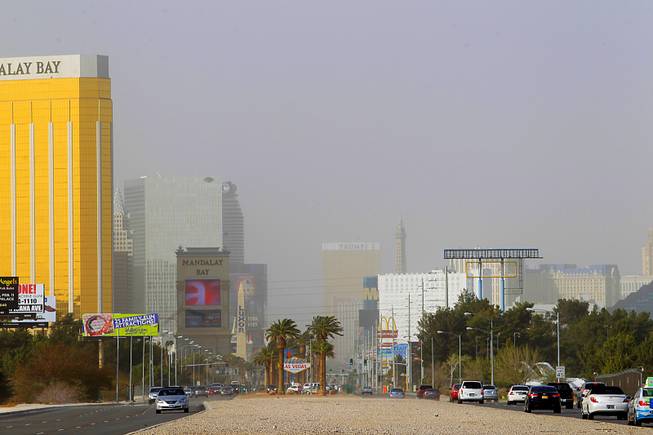
The Strip is obscured by airborne dust on a windy day in Las Vegas Tuesday, March 6, 2012.
Wednesday, April 25, 2012 | 6:32 p.m.
Despite smog still at dangerous levels, air quality is improving in Las Vegas, according to a new American Lung Association report.
The association, in its State of the Air 2012 report released Wednesday, said Las Vegas dropped out of the nation’s 25 cities with the most ozone pollution. The city is now No. 28 and its air is the cleanest it has been since the annual report started 13 years ago, the association said.
The report grades cities and counties based partially on daily federal Environmental Protection Agency alerts of unhealthy air conditions. The report covers particle (dust) and ozone (smog) pollution data collected from 2008 through 2010.
The improvement reported by the American Lung Association doesn’t mean Las Vegans should breathe easy about smog in the valley, however. Las Vegas’ smog levels, the association said, still are unacceptable.
“They gave us an F,” said Dennis Ransel, an air quality planning manager for Clark County’s Department of Air Quality.
Ransel said the American Lung Association’s report was not based on the air quality standards, which Clark County meets.
The lung association gave Clark County a B grade for short-term particle pollution.
“Our dust pollution has been reduced dramatically,” said Ransel, who was in agreement with the lung association’s assessment.
The lung association said dangerous levels of either ozone or particle pollution can cause wheezing and coughing, asthma attacks, heart attacks and premature death. Those at greatest risk from air pollution include infants, children, older adults, anyone with lung disease like asthma, people with heart disease or diabetes, people with low incomes and anyone who works or exercises outdoors.
Ozone is created by sunlight reacting to emissions produced by vehicles and other sources. Several factors play a part in ozone levels, such as the weather and types of fuel used in vehicles.
“We’ll have to look for ways to reduce emissions and improve air quality,” Ransel said. “We’re on the right track.”
“State of the Air shows that we’re making steady progress in cutting dangerous pollution from the air we breathe, thanks to the lifesaving protections under the Clean Air Act,” Amy Beaulieu, director of programs for the American Lung Association in Nevada, said in a statement. “But the job of cleaning the air is not finished. Despite these improvements, America’s air quality standards are outdated, putting the health of millions of Americans at stake.”

Join the Discussion:
Check this out for a full explanation of our conversion to the LiveFyre commenting system and instructions on how to sign up for an account.
Full comments policy